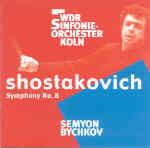Comparison between this version and Rudolf Barshai’s with the same orchestra on Brilliant Classics is instructive. Barshai plays the opening of the symphony as Shostakovich writes it–namely, as a long melody for strings with the notes bound together in arching phrases. In contrast, Semyon Bychkov inserts little pauses between long and short notes. Not only is this just plain wrong in terms of the rhythm (particularly evident in slow tempos such as this), but it breaks up what should be a melody into a patchwork of gestures. Doubtless what Bychkov was aiming for was emphasis, but Barshai generates far more intensity even at a slightly slower tempo by creating the feeling of forward movement and allowing time for the sonority of the lower strings to register properly. And you really hear the music’s anguished lyricism too. In sum, Bychkov plays notes; Barshai makes music.
This is just a tiny example of Bychkov’s superficial and generic way with this symphony, and with his Shostakovich in general. The fact is, neither here nor in his previous Philips recordings does he show any special affinity for this music. The fact that he’s Russian counts not a bit. Every collector knows that some of the worst recordings of Russian music come from Russia, and the same observations regarding phrasing and rhythm apply to the remainder of the symphony as well. The fearsome third-movement toccata sounds notably more mechanical and evil in Barshai’s hands, thanks to a slightly slower tempo, while in the finale Barshai’s easeful flowing and ability to connect phrases makes the final climax all the more heartbreaking. I sometimes wonder if Bychkov really feels this symphony emotionally; there’s nothing here in either the conducting or the playing beyond a cool (if high) standard of technical professionalism. As they did for Barshai, the engineers of WDR deliver fine sonics, but this isn’t by any stretch of the imagination great Shostakovich.
































